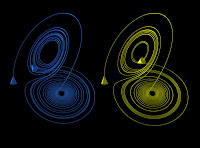If conceived as a series of ever-wider experiential contexts, nested one within the other like a set of Chinese boxes, consciousness can be thought of as wrapping back around on itself in such a way that the outermost 'context' is indistinguishable from the innermost 'content' - a structure for which we coined the term 'liminocentric'.
As most know "Liminocentric structure" will have been defined here then? I like to think this goes back much further in our natures, and to recognize this pattern, much as Brian Greene might have spoken too, in article above one would have ot venture into it to understand.
Then why would I inject past historical views here to current research? It is a issue of wholeness and bringing resolution to the camps of LQG and Strings. If you look at the circle here in an expansitory view. The circle as a point, deals with particle reductionistic principals as well as dealing with General Relativity on a cosmological scale. They both deal with gravity from their respective positions. What are their strengths and weaknesses?
I will be away for about two weeks and a much needed break, so I hope people will explore this avenue, for it is the basis of my research in understanding this interchange between, depending on which circle you belong, two ends that need to come together and in this regard, LQG and String theory might have found this unification, but from which different ends?
There is no end, and it is continous by nature?
One harmonious possibility is that string enthusiasts and loop quantum gravity aficionados are actually constructing the same theory, but from vastly different starting points. That each theory involves loops-in string theory, these are string loops; in loop quantum grvaity, they're harder to describe nonmathmatically, but. roughly speaking, they'r elementray loops of space-suggests there might be a connection. This possibility is further supported by the fact that on a few problems accessible to both, sucha s blackhole entrophy, the two theroies agree fully. And on the question of spacetime's constittuents, both theories suggest that there is some kind of atomized structure. Page 490, Fabric of the Cosmos by Brian Greene
To me this connection lies in how we interpret the circle and this variation in between them, is a powerful topological structure form that is understood as we see the question of which circle is which? From which space quantum mechanically to cosmologicazlly. In terms of that atomized look, to the nature of relativity through that cosmo.
The last departing statement in Brian Greene's book sets the stage for how the string community has to orientate its view from one perspective, while LQG needs to orientate theirs. This is used, to point to ISCAP and the introduction Brian Green gives us.
Look at Page 493 of his book, and then look here.
The goal of ISCAP is to bring together theoretical physicists, astrophysicists, and observational astronomers to address key problems in particle physics and cosmology that require a broad confluence of expertise and perspective.
Even the good intention would have failed to see this connection between both camps, but I see that having it explained as such here, I hope to point to something much deeper in our psyche that warrents the orientation to mathematcial structures that underlies our consciousness. As subjective a view as it might seem to some, there are reasons that I support such views, and without hurting the purity of the direct mathematical relations, I needed to bring the article and title of this entry forward for consideration. It is a necessary part of wholeness that the dicrete natures and the wonderful views of continuity would share some relationship even in the bulk of our considerations?
Which Circle do you belong too? You are one, and the same are you not?:)
"Nothing to me would be more poetic; no outcome would be more graceful ... than for us to confirm our theories of the ultramicroscopic makeup of spacetime and matter by turning our giant telescopes skyward and gazing at the stars," Greene said.
The Elegant Universe, by Brian Greene, pg 231 and Pg 232
"But now, almost a century after Einstein's tour-de-force, string theory gives us a quantum-mechanical discription of gravity that, by necessity, modifies general relativity when distances involved become as short as the Planck length. Since Reinmannian geometry is the mathetical core of genral relativity, this means that it too must be modified in order to reflect faithfully the new short distance physics of string theory. Whereas general relativity asserts that the curved properties of the universe are described by Reinmannian geometry, string theory asserts this is true only if we examine the fabric of the universe on large enough scales. On scales as small as planck length a new kind of geometry must emerge, one that aligns with the new physics of string theory. This new geometry is called, quantum geometry."


